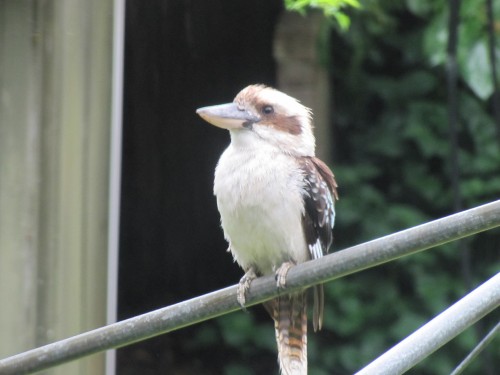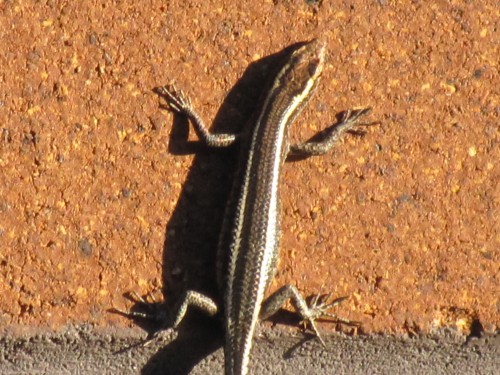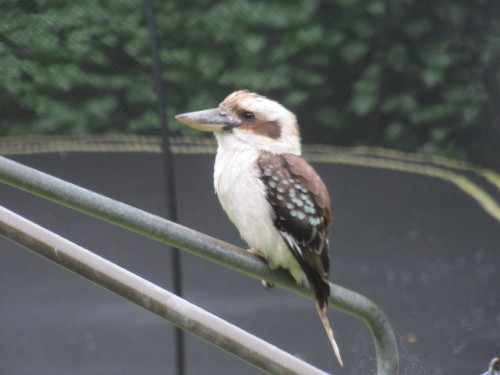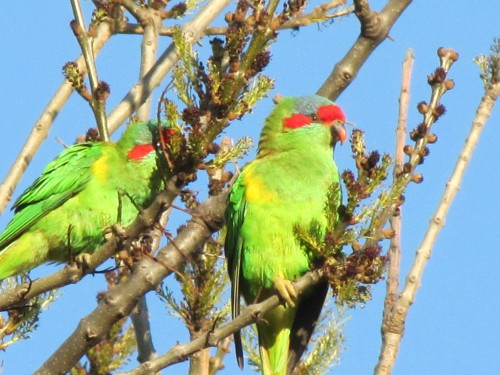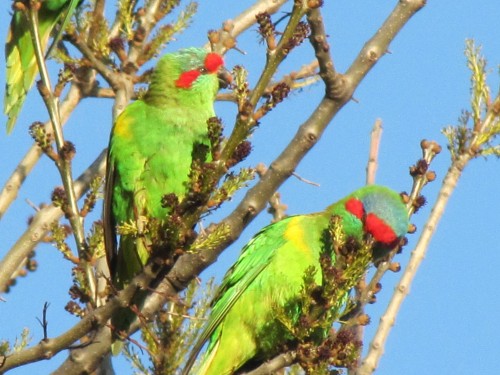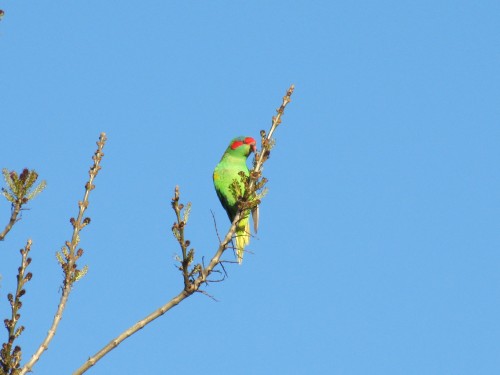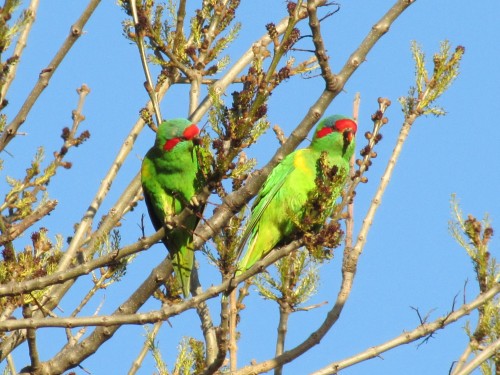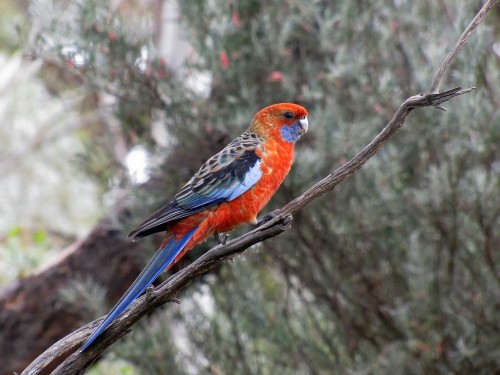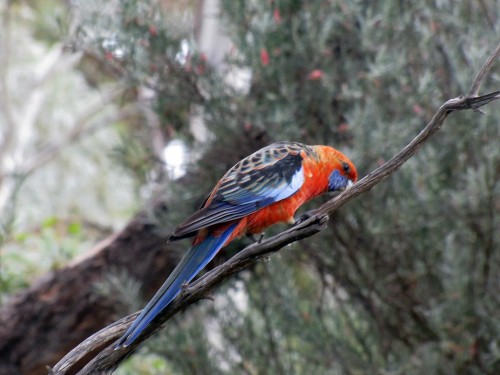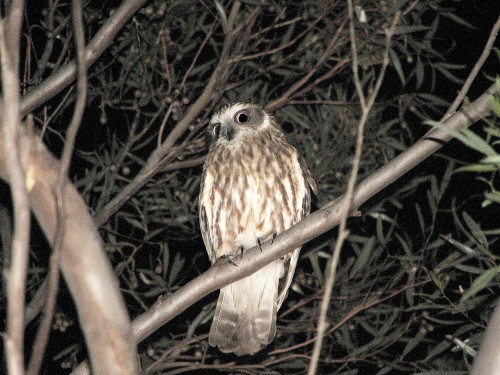Laughing Kookaburra, Artarmon
Over Christmas last year we stayed with family in Artarmon on the north shore in Sydney. Almost every day we heard Laughing Kookaburras somewhere near the house, usually around 4:30am every morning. It was a pleasant wake-up call, albeit a little early.
From time to time my family enjoys seeing a kookaburra visit their back yard, often perching on the clothes line. I guess that they enjoy visiting and picking up for lunch any small skink (a small lizard – see photo below) that is a little tardy in moving to shelter out of sight.
Update Oct 1st 2015: I have recently been talking on the phone with my 7 year old grandson several times a week in recent weeks. He has developed an interest in the local birds (I wonder where he developed that interest?). He has told me that he regularly sees and hears the kookaburras in his garden, in the street where they live and in nearby parks where he goes riding his bike. On enquiring about the resident skinks, he told me that they see many of them every day they are in the garden, but the blue-tongue lizard which used to live under their front steps is no longer there.
For a discussion on the identification of the skink, please read the comments.
Further reading:
- A Laughing Kookaburra comes to lunch
- Interrupted by a Kookaburra
- The skink I referred to is a Common Garden Skink Lampropholis guichenoti
Article updated 1st October 2015.
Pesky Musk Lorikeets
Last Sunday I was in my daughter’s back yard in Clare sitting in lovely winter sunshine. I was intent on the novel I was reading and trying hard not to doze off in the warmth of the sun on my back. A small flock of about a half dozen Musk Lorikeets noisily flew into the neighbour’s almond tree.
I firstly checked them out with the binoculars; I’ve also seen Purple-crowned Lorikeets in this locality. I then grabbed my camera and quietly walked to the fence. Zooming in I could see that they were not going to be easily spooked. The unopened flower buds on the almond tree were obviously good eating. In the next two minutes I managed to get 18 really good photos, some of which I share on this site today.
Musk, Purple-crowned and Rainbow Lorikeets are relatively common and widespread throughout the Mt Lofty Ranges and the mid-north of South Australia, and elsewhere such as the south-east of the state. They can be seen in some places in large numbers, noisily feeding in eucalypt trees in particular.
When they are feeding in the dense canopy of a gum tree (eucalypt) they can be very hard to see, let alone photograph. So seeing them feeding in a tree with little foliage made photography so much easier for me. I wish all birds were so accommodating.
Further reading:
- Purple-crowned Lorikeets at Brown’s Road Monarto
- Purple-crowned Lorikeets
- Rainbow Lorikeets feeding
- Lorikeets and flowering trees
A colourful visitor to our garden
Last week while we were having breakfast in our sun room, we had a very colourful visitor. This Adelaide Rosella, a sub-species of the more common Crimson Rosella, came to check out our bird bath. Sadly, I had neglected to top it up over the last week or so and we’d had some windy and sunny days and it was dry. The rosella stayed for only a few moments before flying off.
Adelaide Rosellas are common in the Mt Lofty Ranges some 50km to the west, and through the mid-north of South Australia. Here where I live in Murray Bridge 80km west of Adelaide, they are widespread but not common.
The red on the feathers varies from almost a deep crimson, as in the Crimson Rosella, through to a very washed out orange. Further upstream along the River Murray, another sub-species, the Yellow Rosella is quite common.
Further reading:
A special call in the night
A few night ago we were suddenly aware of the familiar call of a Southern Boobook owl quite close to our house. I only took a few moments to locate it in the large tree next to our clothes line. I didn’t bother getting out the camera to get some photos because the last time I saw one in our garden I got the photo shown above. It is quite possibly the same bird.
It has been some time since we heard a Boobook in our garden; usually we have the television going at night and that tends to drown out the night sounds. On this occasion we had both been working on cleaning out the office, so the television was off. Perhaps we should do that more often!
Much to our delight we heard it calling again the following night. It would be lovely to be able to call it a resident bird present nearly every night, instead of just an occasional visitor every few years. It is quite welcome to move in and can have all the mice it can catch while it stays.
Further reading:
World record set by birder
I regard myself as a devoted and keen birder. I am not a twitcher – I usually can’t be bothered going to see a rare bird even if it occurred a few kilometres away from home. I am not a fanatic – I do have other interests (too many in fact). I do not go racing all over the countryside in order to see birds.
But I am a lister of birds seen. I keep day lists, month lists, year lists and a life list. None of them are very big because I do not regard birding some kind of competition or race to see the most species. I do keep all of my sightings on a database stretching back as far as 1977. I guess that is bordering on fanaticism.
I do admire birders who dedicate a whole year to seeing as many species as possible. Even more, I envy birders who have had the opportunity to travel to almost every country of the world in order to make a life list of thousands of species. Their single mindedness to the task is admirable, and I hope that they have fun doing it.
Until a few days ago I had not heard of world record holder for having seen the most bird species on a global scale. I had read about a previous record holder Phoebe Snetsinger, but the name of Tom Gullick was a new one to me. At age 81, this dedicated Englishman is the first person to have seen over 9000 different bird species in a lifetime. You can read about him here.
With a world wide life list hovering around just over 400 species, I have a long way to go to catch up. I haven’t even seen half of Australia’s bird species yet. [Sigh]
